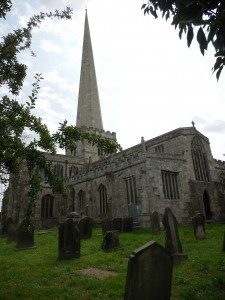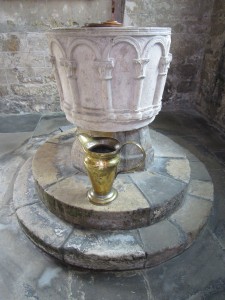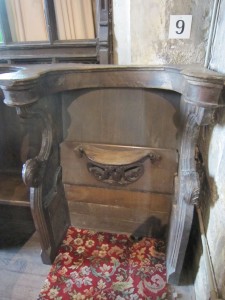The parish of Hemingbrough is situated in the flat and often flooded area that once made up the wapentake of Ouse and Derwent, part of the historical East Riding of Yorkshire (see maps in Introduction). Before the 1832 parish boundary changes it included the subparishes and localities of Babthorpe, Barlby, Bowthorpe, Brackenholme, Cliffe, Hagthorpe, Lund, Menthorpe, Osgodby, South Duffield, Turnham Hall and Woodhall.
Before the Conquest Hemingbrough was in the hands of the Earl Tosti. It is likely that the men of the town joined his insurrection against Harold and fought by his side at the battle of Stamford Bridge. The rebellion would bring the manor of Hemingbrough by forfeiture to William I, who gave it to the bishop Durham, and he in turn assigned it to St Cuthbert’s priory. At the Dissolution it was restored to the Crown, which in 1614 granted it two local families, and it has remained in private hands until the present day. No manor house survives today, but a 19th century house called Manor Farm probably incorporates an earlier building. A smaller estate in Hemingbrough belonged to the guild of St. Christopher and St. George, York, which after the Dissolution was granted by the Crown to York Corporation.
A feature of Hemingbrough is the large number of yeomen who were occupants or owners of the same lands for several centuries. Prior to the Reformation their landlords in Durham were exceptionally indulgent, lowering rents during hard times, often excusing arrears and ensuring that promising young men received an education. The Reformation made little difference as far as tenancies were concerned; on the contrary, the break-up of the monastic estates meant that more land came onto the market. However, the industrial revolution brought about a gradual decline in agriculture, when falling prices meant that the yeomen were no longer able to make a living, driving them first to mortgaging the plots they had farmed since time immemorial and then reluctantly selling them to newcomers who had no attachment to the land.
Though the yeomen of Hemingbrough benefited from their unique ownership and tenancy arrangement during the Reformation, in no part of the country did the inequalities and hardships inflicted by the change fall with more force than in the surrounding parishes, and in no part of Yorkshire did so many people cling to the old faith. It was therefore not surprising that rebellion against the Reformation broke out on the banks of the Derwent. It had its headquarters at Wressle Castle, where Sir Thomas Percy supported the cause, and involved other members of the northern nobility, including – briefly – Sir William Babthorpe of Osgodby, who escaped execution after the rebellion’s failure, though its leader Robert Aske, Sir Thomas Percy and Sir Francis Bigod did not.
 west window |  east window |  font |  oldest misericord in UK |  now occupied by the organ |
A church was recorded at Hemingbrough in 1086. It too was given to the bishop of Durham soon afterwards and assigned by him to Durham priory. Dedicated to St. Mary, it was built mostly of local limestone, from the same source as that used to build York Minster. It contains a chancel with a north vestry and north and south chapels, a central tower topped by a spire, transepts and an aisled and clerestoried nave with a south porch. The two eastern bays of the nave are late 12th century, but they have been cut through the walls of an earlier building which probably dates from the 11th century. Soon after 1200 the nave and aisles were extended westwards by two bays, and a north transept with a narrow aisle on its west side was added. The south transept is late 13th century and the lower storey of the vestry mid 14th century. The south aisle was widened and the south porch added at about the same time. The spire dates from the 15th century, as do a number of the windows, the Babthorpe chantry chapel and the room over the vestry, while the Lady chapel is early 16th. Many of the medieval fittings, including the rood screen and much stained glass, have gone, but among those that remain are the font of c1200 and a single misericord of c1300, said to be the oldest in England. The church was already large when it was made collegiate in 1427, the last in the north to which the collegiate system was applied, with a staff comprising a provost, three prebendaries, six vicars, and six clerks. The college was suppressed in 1545 eventually became a vicarage.

The college’s provosts lived in a building later called Prior House, standing in Hall Garth, on the south side of the church. After the suppression of the college it was granted in 1554, along with 30 acres of glebe lands, to Joan and John Constable, but was no longer in their possession by 1662. It had nine hearths in 1672 and was reportedly demolished in 1697 and the materials used to rebuild Osgodby Hall. In 1554 the Constables were also granted the former bedern of the vicars of the college, which perhaps stood near the provost’s house.

Babthorpe belonged to King Edward before the Conquest, and formed part of the bishop of Durham’s manor of Howden in 1086. Its population was estimated at five households, making it one of the smallest 20% of settlements recorded in Domesday. If the hamlet of Babthorpe is known further afield, it is by its association with the family who lived there and took its name in c1190. The site of their old manorial complex was surrounded by a moat and bisected by another, creating two islands, one where the house stood and the other given over to farm buildings. The medieval manor house, of which only foundations remain today on the main island, was described in 1437 as consisting of a hall, chapel and thirteen chambers, with buttery, pantry, kitchen, etc., while the other island housed two barns, two stables, cowbyres and pigsties. In the late 15th century the estate was assigned to a related branch of the Babthorpes living in nearby Osgodby. They sold it in 1621, after which it passed through various hands until it was acquired by the East Riding County Council in 1920. Today the area is occupied by Babthorpe Hall Farm.

Barlby belonged to King Edward and Merleswein, sheriff of Lincolnshire, before the Conquest, the king’s share going the bishop of Durham and the sheriff’s going to Ralph Paynel in 1086. Ralph Paynel granted his part to Holy Trinity Priory in York; thereafter both passed into private hands. In the mid 12th century Gilbert de Aton, who styled himself Gilbert of Barlby, held the manor. His descendants were a succession of Williams and Gilberts until the last William de Aton’s only son died in 1383, leaving William’s three daughters as co-heiresses. Elizabeth’s share has not been traced, but it is likely that it eventually came into the hands of the Babthorpe family, as did Anastasia’s and Catherine’s shares. In 1621 Sir William Babthorpe sold Barlby to Richard Bowes, and from the Bowes family it passed to the Strangeways and later into other private hands. There was medieval manor house at Barlby which probably stood on a moated site later called the Island. It passed to the Lodge family in the early 16th century and was held by the Lodges until the death in 1717 of Ralph Lodge, who was succeeded by his sisters Eleanor Spofforth and Elizabeth Lacy. Thereafter it passed through various hands. The old house was demolished at the beginning of the 18th century and a new house erected, and the Island, the box hedges and other marks of antiquity became a garden. In the early 19th century the new house was rebuilt in red brick with a slated roof and a pediment over the centre front and is known as Barlby Hall. By 1482 a chapel dependent upon Hemingbrough church was already existing at Barlby. But by the late 18th century it was in a ruinous state and replaced by the current brick church dedicated to All Saints.

The name Pickering was first associated with Hemingbrough through Richard Pickering who was rector of the church between 1409 and 1412. He was undoubtedly a member of the Oswaldkirk family, as his arms – gules a chevron or between three fleurs-de-lis argent – are very similar to the others used by this family (see Name and Arms). They have now disappeared from the windows of Hemingbrough church along with others with Babthorpe in chief and Waterton in base, impaling Pickering as above, a crescent for difference. They were probably the arms of Robert Babthorpe, esq. (d1496), who chose as his bride a member of the Pickerings of Barlby. A more tenuous link between the Pickerings and Hemingbrough is illustrated by the prior of Durham seeking advice in c1453 from Sir James Pickering III of the Pickerings of Killington regarding the Priory’s fisheries in the Ouse and Derwent. However, it was the Pickerings who lived in Barlby for four generations, no doubt descendants of the Oswaldkirk family, who are the best represented in the parish of Hemingbrough.
Sources:
Hemingbrough:
https://www.genuki.org.uk/big/eng/YKS/ERY/Hemingbrough
https://en.wikipedia.org/wiki/Hemingbrough
https://opendomesday.org/place/SE6730/hemingbrough
Victoria History of the County of York, East Riding, vol. 3, pp. 37-66: https://www.british-history.ac.uk/vch/yorks/east/vol3/p37
History and Antiquities of Hemingbrough: https://archive.org/details/historyantiquiti00burt/page/n6
Monasticon Eboracense: https://archive.org/details/b30459667/page/n459
Church of St. Mary the Virgin: https://historicengland.org.uk/listing/the-list/list-entry/1148462?section=official-list-entry
Babthorpe:
https://opendomesday.org/place/SE6929/babthorpe
Victoria History of the County of York, East Riding, vol. 3, pp. 52-55: https://www.british-history.ac.uk/vch/yorks/east/vol3/pp52-55
Barlby:
https://opendomesday.org/place/SE6334/barlby
Victoria History of the County of York, East Riding, vol. 3, pp. 47-52: https://www.british-history.ac.uk/vch/yorks/east/vol3/pp47-52
